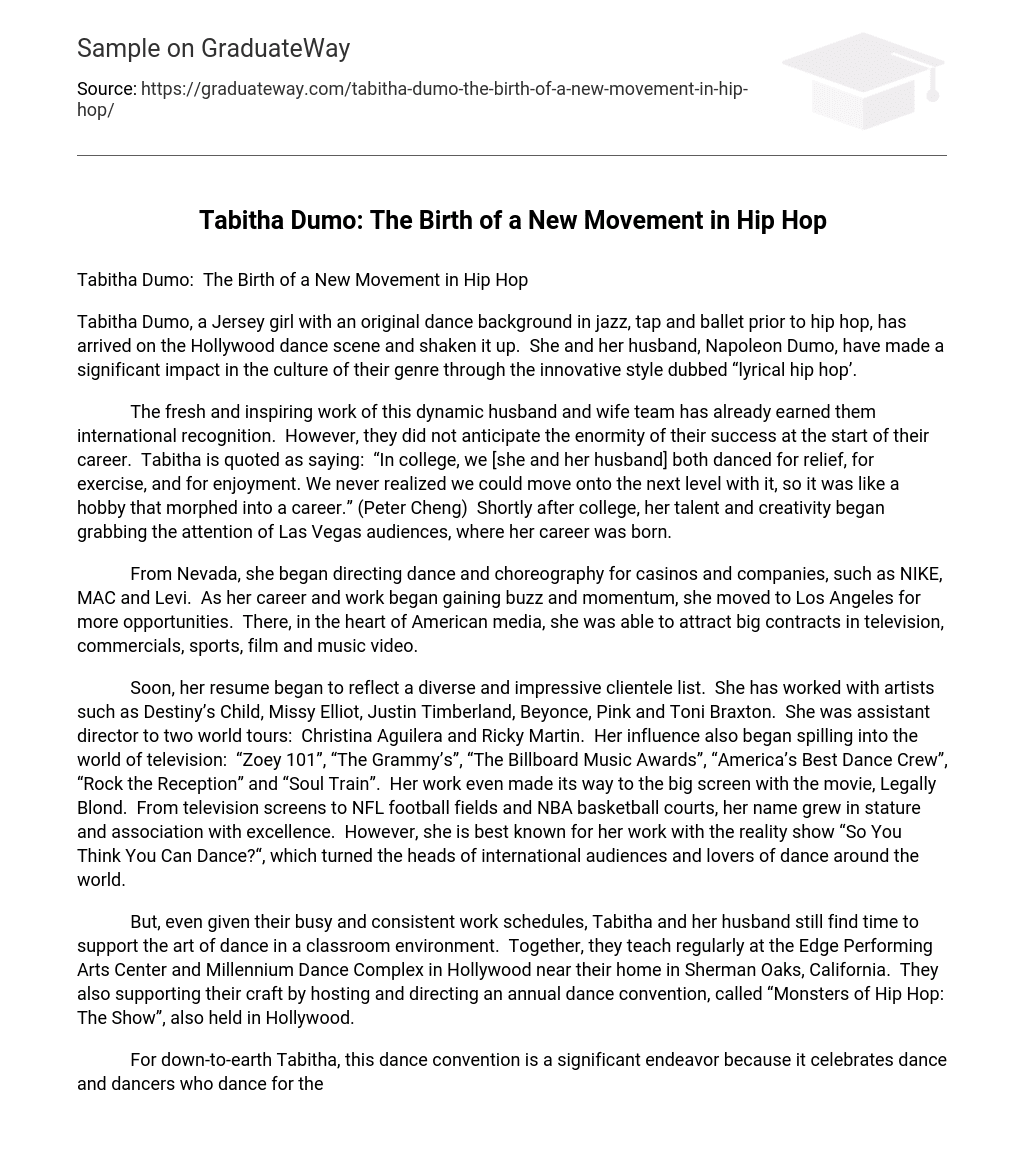Tabitha Dumo, a Jersey girl with an original dance background in jazz, tap and ballet prior to hip hop, has arrived on the Hollywood dance scene and shaken it up. She and her husband, Napoleon Dumo, have made a significant impact in the culture of their genre through the innovative style dubbed “lyrical hip hop’.
The fresh and inspiring work of this dynamic husband and wife team has already earned them international recognition. However, they did not anticipate the enormity of their success at the start of their career. Tabitha is quoted as saying: “In college, we [she and her husband] both danced for relief, for exercise, and for enjoyment. We never realized we could move onto the next level with it, so it was like a hobby that morphed into a career.” (Peter Cheng) Shortly after college, her talent and creativity began grabbing the attention of Las Vegas audiences, where her career was born.
From Nevada, she began directing dance and choreography for casinos and companies, such as NIKE, MAC and Levi. As her career and work began gaining buzz and momentum, she moved to Los Angeles for more opportunities. There, in the heart of American media, she was able to attract big contracts in television, commercials, sports, film and music video.
Soon, her resume began to reflect a diverse and impressive clientele list. She has worked with artists such as Destiny’s Child, Missy Elliot, Justin Timberland, Beyonce, Pink and Toni Braxton. She was assistant director to two world tours: Christina Aguilera and Ricky Martin. Her influence also began spilling into the world of television: “Zoey 101”, “The Grammy’s”, “The Billboard Music Awards”, “America’s Best Dance Crew”, “Rock the Reception” and “Soul Train”. Her work even made its way to the big screen with the movie, Legally Blond. From television screens to NFL football fields and NBA basketball courts, her name grew in stature and association with excellence. However, she is best known for her work with the reality show “So You Think You Can Dance?“, which turned the heads of international audiences and lovers of dance around the world.
But, even given their busy and consistent work schedules, Tabitha and her husband still find time to support the art of dance in a classroom environment. Together, they teach regularly at the Edge Performing Arts Center and Millennium Dance Complex in Hollywood near their home in Sherman Oaks, California. They also supporting their craft by hosting and directing an annual dance convention, called “Monsters of Hip Hop: The Show”, also held in Hollywood.
For down-to-earth Tabitha, this dance convention is a significant endeavor because it celebrates dance and dancers who dance for the love of dancing. Through it, they are able to uncover real talent from across the nation and provide undiscovered artists a platform to demonstrate their skill and passion. Tabitha explained to an interviewer: “It’s great when we work on industry shows, but being a part of these conventions is a breath of fresh air. We get to travel to smaller regions and meet kids who don’t get that kind of exposure. Seeing their drive, passion, and hunger is a really cool experience for us. They are the next generation of dancers, and we want to try and complete that circle.”
As an ardent enthusiast, the legacy of dance is important to Tabitha and she is a part of that legacy. She and her husband will be remembered for their enduring contributions to the world of hip hop. They have demonstrated a unique ability to create strong routines that stir feeling and generate thought.
“With so many choreographers and dancers trying to climb to the top, Tabitha and Napoleon are stand-outs among the rest.” (Peter Cheng) In part, due to their prolific influence of dance in the media; in part, due to the strength of their creative collaboration; but, largely, due to their striking and novel use of lyrical hip hop. Through the medium of this brilliant and thoughtful style of dance, they are able to engage the audience with a genuine moment of emotional connection. “The main component to their success seems to lie within the fact that they make their craft relatable to the general audience. This extra effort and consideration is the key to their popularity.” (Peter Cheng)
Tabitha has learned to infuse her choreography with energy, animation and raw emotion. She is taking hip hop to another level of storytelling and imagination. “What is completely different about their routines is that they are no longer just tricks and hitting hard; they mean something.” (Jesse Petersen) Retaining hip hop’s best elements (high energy, hard hitting, popping and jaw dropping wow-moments), she’s including an emotional bond that draws audience members into the performance and leave them with a memorable experience. Her work will endure marking the birth of a new and powerful movement in hip hop.
Works Cited
Cheng, Peter. “Lovers of Hip Hop.” Gloss: The Fashion Magazine. 23 April 2009.
<http://www.glossmag.ca/issues/14/arts/4-nappytabs.html>
Petersen, Jesse. “Lyrical Hip Hop Takes Center Stage”. 25 July 2008. The
Expressionist. 23 April 2009. <http://www.theexpressionist.com/2008/06/25/lyrical-hip-hop-takes-center-stage/>





